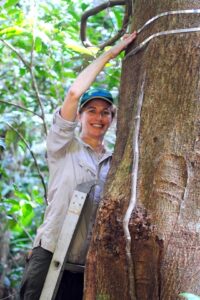How might the world’s rainforests respond if droughts become more frequent in the future?
This question is behind a unique experiment being established in the world-famous Daintree rainforest at the Far North Queensland Rainforest SuperSite, part of TERN’s Australian SuperSite Network.
Taking advantage of a 47m tall construction crane operated by James Cook University (JCU), scientists are studying how trees and other plant life-forms at all vertical levels of the forest respond to a prolonged, experimentally induced drought.
Led by ARC Future Fellow Susan Laurance, an associate professor at JCU, the experiment will contrast demographic and physiological responses of an array of plant species between experimental and control plots where tree growth, composition, soil water and atmospheric exchange have been monitored with TERN environmental data since 1999.
The experimental structure is the size of a football field (100 x 50 m) and will remove about 40% of the dry-season rainfall. Under the rainforest canopy, panels of clear plastic will capture rain and a system of gutters and channels remove it from the site.
One complication is that Australian rainforests occur within the cyclone zone, where extreme rainfall events and falling debris can easily overwhelm and possibly damage the drought equipment. To forestall this possibility, the experiment will mostly focus on reducing dry-season rainfall rather than attempting to function throughout the year, particularly during the wet season when cyclones occur.
‘Reducing dry-season rainfall is highly relevant because this is what tends to happen during El Niño–Southern Oscillation (ENSO) related droughts,’ says Susan. ‘Understanding the effects of such droughts will become even more vital as recent climate models suggest that global warming will intensify ENSO droughts this century, especially in the western Pacific region.’
Inducing a drought in the field is logistically and financially difficult. But it is important to operate at a relatively large scale because many adult trees have laterally extensive root systems. Given the logistical challenges it is not possible to replicate the experiment, but the study was designed as a BACI (Before-After-Control-Impact) experiment, which does not require replication.
The priorities in the study are to collect data on tree demography, plant functional traits and plant water use prior to the drought. The latter will be investigated via a large array of sap-flow meters on eight species of trees with plans to extend the study to lianas and shrubs.
The Daintree Drought Experiment is an ambitious project that will address one of the most important potential threats to tropical forests. This is a vital undertaking, given that droughts could imperil the capacity of rainforests to store carbon and sustain biodiversity.

Susan Laurance installing a dendrometer band on a Daintree rainforest tree (Photo courtesy of Dr Alex Cheesman)
Published in TERN newsletter January 2014






